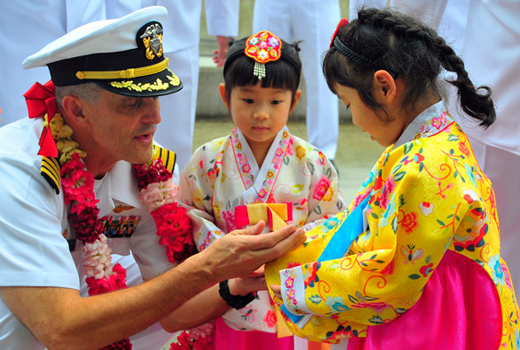Admiral Sam Locklear on Indo-Asia-Pacific Challenges & Opportunities
Why does the Asia Pacific region matter to the American people and the global population at large? The answer is self-evident when one realizes the area “really can’t be called a ‘region’ because it’s too large,” explains Admiral Sam Locklear. With more than 50 percent of the world’s surface, it encompasses more than one-half of the world’s population, and that number is increasing. Locklear, commander of the U.S. Pacific Command (PACOM), the largest and oldest Combatant Command (COCOM) in the U.S. military structure, says his area of responsibility – what he terms the “Indo-Asia-Pacific” – “is incredibly culturally, socially, economically and geopolitically diverse.”
Many of the 36 nations associated with PACOM are conspicuously unique in their attributes. Locklear says the area contains two of the three largest (United States and China) economies and seven of the smallest economies in the world. It also contains the world’s most populated nations (China, India and the United States), largest democracy (India), largest Muslim majority nation (Indonesia), which is also a democracy, and the smallest republic (Nauru). In addition, nine of the 10 largest ports are in this area. According to the Commander, this equates to the “busiest sea lanes in the world with more than $8 trillion in two-way trade with one-half of the world’s container cargo passing through the Indian Ocean every day and more than 70 percent of all shipboard energy supplies passing through this area of the world every minute.”
Locklear also says it is the most militarized area of the world with seven of the 10 largest standing militaries, the largest and most sophisticated navies, and five declared nuclear nations (United States, China, India, Russia and North Korea). “Put all this together and it creates a complex scenario not only from a security but also from a whole of government perspective. The unique strategic complexity is exacerbated by historic and emerging border and territorial disputes,” explains the PACOM Commander. “Although some of these are playing out now in the South China Sea and Senkaku Islands, we should all recognize that territorial disputes like these are global in nature and not just isolated to this one part of the world.”
The Indo-Asia-Pacific also has challenges to access and freedom of action in the shared maritime, air, space and cyberspace domains. With increasing interest in the protection of their natural resources, countries are becoming more focused on their ability to control and dictate what happens in the maritime domain. “I think the world needs to look at this very carefully to make sure freedom of access, freedom of movement, freedom to maintain security over national interests, wherever they may be globally, is not impeded by restrictions on maritime access to that domain,” comments Locklear.

U.S. Navy photo by Mass Communication Specialist 2nd Class David Hooper |The USS Stockdale (DDG 106) is underway in formation as part of the Nimitz Carrier Strike Group Surface Action Group (SAG) as they transit the western Pacific Ocean.
Another shared domain is air, which the Commander thinks is better policed due to commercial air traffic, but he says it is not without its challenges. The space domain, on the other hand, is increasingly important as countries look more at their external vs. internal security issues. “When I came into the military 40 years ago, space wasn’t a big topic with respect to the security environment. But, today that’s changing exponentially whether from communications or national technical means that provides intelligence of warning. Space is generally ungoverned, and we’re not respecting it very well,” explains Locklear. “Only about 50 percent of objects in Earth’s orbit produce something beneficial for mankind. The other 50 percent are basically floating space junk created by explosions, collisions and bad policy in space. So, we’re going to have to get serious about it, or we’re going to have an unusable space in the future.”
The final ungoverned and only man-made shared domain is cyberspace, which the PACOM Commander says is probably the least governed and most vulnerable domain from a security perspective. “Most people see cyber through the end of a cell phone or personal device, and they believe it’s just massive information floating around in the RF (radiofrequency) network. In reality, most everything that flows in the cyber world flows on land lines and lines under the seabed,” explains Locklear. “Those cables and landlines are proliferating globally and every time one is hooked up, it creates another node where someone who may want to misuse cyberspace could have access.”
The PACOM Commander compares the current cyber domain to the Wild West in the second half of the 19th Century, i.e. the only security was what a person brought with him or her. He says both state and non-state actors are stealing intellectual property and other vital information off the internet. With militaries more prone to use the internet to manage, position and resource forces and to make command and control decisions, these security challenges become particularly problematic. “Certainly President Obama’s recent commitment to stand-up the U.S. Cyber Command, at least from a military perspective, is a step in the right direction. We’re working hard to make sure we have information assurance, proper access to networks that can’t be attacked, well-protected information and a cyberspace domain where the security risk is minimized. But, there’s much work to be done here,” explains Locklear.
Stepping back to threats and challenges in the PACOM theatre, the Commander says instability on the Korean Peninsula is clearly persisting. “North Korea today is not our grandfathers’ North Korea. It’s now a North Korea that has a third generation dictator, that has made minimal progress in improving its citizens’ quality of life and that claims to have nuclear capability with an ICBM (intercontinental ballistic missile) capability,” comments Locklear. “All this adds to the complexity of how we’re going to have to deal with North Korea. Since the Armistice Agreement was signed 60 years ago and the DMZ (Korean Demilitarized Zone) was established, little progress has been made other than relative stability on the Korean Peninsula. But that stability comes at a high cost for miscalculation and a high cost for military hardware that has to be positioned by North Korea, South Korea and the United States from an alliance perspective. That threat continues, and in my view, it appears to be getting worse.”
Then there is the question of China and, to a lesser degree, India. How do they emerge as global economic and regional powers, and how are they integrated into an established and generally peaceful and stable security environment? “There’s a lot of speculation about China and its behavior. But, in the end, it’s in the best interest of China, and it’s in the best interest of the United States and global peace and prosperity for them to be brought into a security environment where they are productive and not on the outside,” says Locklear. “So, we’re working on that, but it’s a challenge. It will take time, and it will require a pretty robust dialogue not only with the Chinese but also with U.S. partners and the five U.S. treaty allies in the Asia-Pacific.”
Add the volatility of the climate in the Indo-Asia-Pacific, and it becomes even more challenging. About 80 percent of the global population lives within 200 miles of the coast, and that number is growing. And that number, according to the Commander, will continue to be challenged by inevitable events like the Fukushima earthquakes in Japan and the tsunami aftermath with its incredible impact on both human suffering and property damage. A few years before, the Indonesian tsunami impacted as far up as Thailand and the Bay of Bengal.
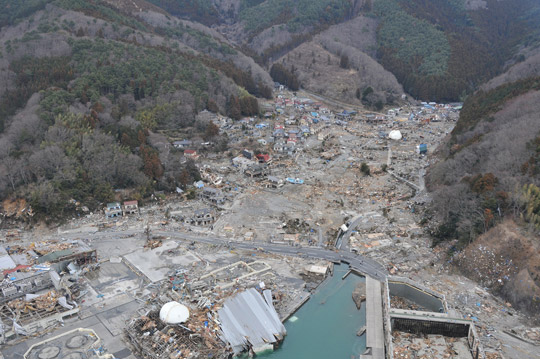
U.S. Air Force photo/Airman 1st Class Katrina R. Menchaca |An Air Force helicopter crew surveys damaged areas near Sendai, Japan,
as part of the earthquake and tsunami recovery effort.
“And this year alone, we’ve had about 27 super-typhoons during typhoon season in the Western Pacific. I’m told the average historical number is about 16.5,” explains Locklear. “PACOM is working hard to help humanitarian assistance/disaster relief (HA/DR) efforts. We’re partnering through bi-lateral and multi-lateral engagement to determine how we, as militaries, can assist our countries and assist the regions in being able to become more effective in dealing with large-scale HA/DR events.”
Other challenges include transnational threats like human slavery, narcotics and the drug trade that people generally do not associate with the Asia-Pacific. But, the Commander says they should probably reset their thinking since a fair portion of human slavery originates in the vast Indo-Asia-Pacific region. According to Locklear’s information, the total amount of money made from human slavery in 2012 was about $30 billion. Compare this to 2011’s three most profitable Fortune 500 companies: Exxon Mobil with $41 billion, Chevron with $26.9 billion and Apple with $25.9 billion. With respect to the narcotics and drug trade, Locklear says, “We have a tendency to think about that through the eyes of a Central America or Gulf of Mexico problem, where we’re working very hard to interdict the flow of cocaine and other illegal drugs into the United States and to try to control the influence cartels have inside our country.
“However, it’s probably not well-known that most precursor chemicals for the drug choice of the day, methamphetamines, particularly in the United States, are being generated in the Asia-Pacific, which are then shipped into North America, Central America and South America. Those chemical precursors end up in meth labs that create methamphetamines sold to our children in elementary, junior-high and high-schools. That’s a significant problem, so in the Indo-Asia-Pacific we have JIATF West – Joint Interagency Task Force West. Although run by a U.S. Coast Guard one star admiral, JIATF West is basically an interagency group that falls under my PACOM command and that works with nations in this vast region to assist them in providing their own internal and external security against transnational threats.”
The above-mentioned are threats and challenges Locklear looks at day-to-day. That said, the real question, according to the Commander, is how to view these threats and challenges going forward, which is where President Obama’s whole of government approach to reshape U.S. priorities comes into play. With Obama’s rebalance or pivot to the Asia-Pacific in mind, Locklear and PACOM are identifing areas where the United States needs to ensure it has the best approach to challenges the nation will face in this region. This strategy recognizes that the United States is a Pacific nation, that its key national interests lie in the Asia Pacific and that this century will be the century of the Indo-Asia-Pacific.
“We’ve been working hard this last year to assure and reassure our allies and partners that we’re going to be here and that we are reliable in the Indo-Asia-Pacific. On the security side, this means we need to work together to produce a security environment that can basically do the same thing that’s been done in the region for the past 60 or 70 years since WWII,” explains Locklear. “Although there’s been conflict in this part of the world, as a general rule it’s been peaceful and prosperous, which has allowed the somewhat dramatic rise of economies, democracies and relatively stable governments in the region.”
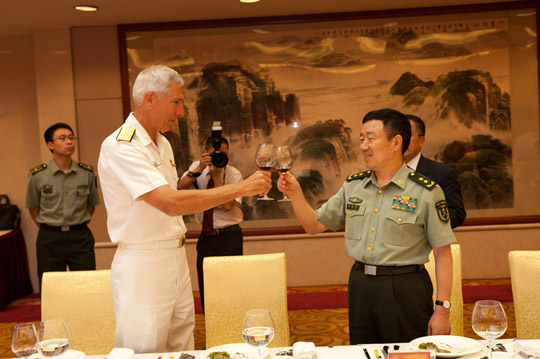
Courtesy: U.S. Pacific Command |Adm. Locklear visits with Chinese military leadership in the People’s Republic of China.
What are the things that will stress the security environment to the point of breaking it, and how does one manage and/or control them? The Commander notes the importance of a U.S. forward presence in this vast region, U.S. interaction with its allies and partners, and U.S. leadership in growing multi-lateral forums and in keeping the dialogue going. He explains that it is important to ensure historic nationalistic tendencies do not emerge and create a fissure in the security environment, which could erupt in a miscalculation leading to a large, complex security environment. According to Locklear, this could even lead to war if not managed properly. The rebalance is required to assure peace, prosperity and security, and to be sure the United States maintains a role in that effort.
“We’re seeing the emergence of what can be credible multi-lateral forums, such as ASEAN (Association of Southeast Asian Nations), ADMM-Plus (ASEAN Defence Ministers Meeting) and the East Asia Summit (an annual summit held by leaders of 16 East Asian countries plus the United States and Russia), which allow people to speak outside the lines of their own internal politics,” explains Locklear. “These are things that are growing in their capacity and capability to deal with and to address not only security but also environmental, trade, transnational crime and other issues.”
The Commander notes that the five alliances the United States has in the Asia-Pacific are good ones. He says the alliance with Japan is strong and growing stronger, as is the alliance with South Korea. The alliance with the Philippines is also very good, although PACOM is “resetting” it as they work to assist the nation in a minimum defense posture and to help them have better situational awareness. Locklear says Thailand is the United States’ oldest ally – 180 years old in 2013 – and PACOM is working to assure this alliance stays as relevant today and in the future as it has been in the past. Australia is also a key ally, one which the Commander says has been with the United States in every major operation since WWII.
“Australia and the United States are very closely aligned in their national objectives and the way they view themselves. And, we continue to build that relationship,” says Locklear. “All our allies and key partners – whether Indonesia, Singapore, New Zealand or India – understand and appreciate the value of a U.S. presence in the Indo-Asia-Pacific from a security perspective and the benefit that has provided everyone. And, they don’t want to see that go away.”
Although India has a policy of non-alignment, the Commander says the United States and India see eye-to-eye. “We are both large democracies; we both have credible militaries; we both have security concerns – theirs maybe not quite so global yet but eventually getting there as their economy grows, and it will grow,” comments Locklear. “We converge with India on many more areas than we diverge. And that’s good news for security, particularly from an Indian Ocean, Bay of Bengal and South Asia perspective. It’s also good as it relates to how the relationship between India and Pakistan evolves. Good, solid leadership in India is beneficial for everything I just mentioned.”
When the PACOM Commander thinks about China, he reminds himself that when he was at the U.S. Naval Academy in the 1970s China was undergoing its difficult and painful Cultural Revolution. “If you look at their topography and history, they’ve been a walled-in society for thousands of years, whether from the Great Wall of China or the Himalayas to the south or the vast, cold regions to the north or their relatively small sea space access to the South China and East China Seas,” says Locklear. “China has been inwardly focused for many, many years. Now they’ve become – maybe sooner than they wanted to – a global economic power – maybe eventually the global economic power.”
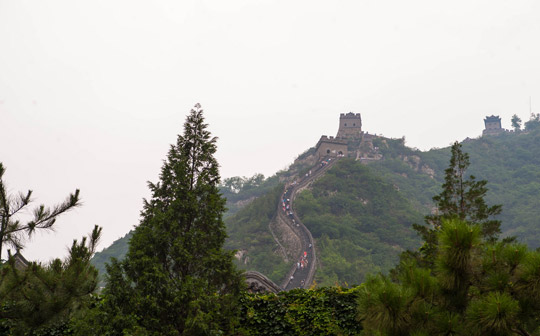
Courtesy: U.S. Pacific Command |Adm. Locklear walks the Great Wall of China on a trip to the People’s Republic of China.
The Commander says China has to come out from behind those walls to go global, which they are doing economically. Next, they must look at the security apparatus that will allow them to make sure their national interests are protected globally in the global security environment. “The fact that China will need and want to do that shouldn’t be a surprise to anybody. The question is how they do that,” explains Locklear. “Do they emerge as a regional leader, and maybe a global security leader at some point, on the inside of the organization able to work under the normal Rule of Law to build consensus, to compromise and to be transparent – all the qualities we like to think people view in the U.S. military as it works globally?”
Can China replicate that process, or will they be on the outside? The PACOM Commander says the dialogue with them is positive. “We’ve had good relationships with them since I’ve been here. We have a much more robust bilateral relationship today with the Chinese military than we’ve ever had in the past, and we hope that continues to grow,” says Locklear. “Over time, a new set of military leaders will emerge in China who have a more global strategic view than maybe we’ve seen in the past. Our hope is to continue to engage them in a dialogue and perspective that will allow for a better U.S.-China partnership and for them to be a net contributor in the security environment.”
But Locklear says areas exist that the two countries clearly disagree on. However, when everything is “stacked up,” the things the nations disagree on are much fewer than those they agree on. “The problem is that the things we disagree on are hard ones. And, the only way to work through hard issues without conflict – at least in the military environment – is to keep talking about them,” says the Commander. “You can’t have a relationship with someone you’re not talking to. So it’s important these communications continue even though it can be difficult at times for both countries.”
Locklear and his Pacific Command have begun a journey in the Indo-Asia-Pacific area that embraces a perspective of equality among nations – one based upon a shared respect for the incredible cultural, social, economic and geopolitical diversity of the region’s people. It is a quiet revolution built on Rule of Law, transparency and the power of consensus building. This revolution embraces similarities rather than differences between countries formerly in conflict and builds upon continuous dialogue rather than gunfire. In this world, peace and prosperity displace hegemony as the ultimate prize, and each nation’s military men and women are the new peacemakers in credible, multi-lateral forums that “allow people to speak outside the lines of their own internal politics.”
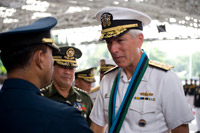
Courtesy: U.S. Pacific Command
Admiral Sam Locklear is a 1977 graduate of the United States Naval Academy. His career as a surface warfare officer includes assignments aboard USS William V. Pratt (DDG 44), USS Carl Vinson (CVN 70), USS Callaghan (DDG 994) and USS Truxtun (CG 35), culminating in command of USS Leftwich (DD 984). Subsequent command assignments include commander, Destroyer Squadron Two; commander, Nimitz Strike Group; commander, U.S. 3rd Fleet; and commander, U.S. Naval Forces Europe, U.S. Naval Forces Africa and Allied Joint Force Command Naples. Ashore, he served as executive assistant to the Vice Chief of Naval Operations; the 78th commandant of Midshipmen, United States Naval Academy; director, Assessment Division (OPNAV N81); director, Programming Division (OPNAV N80); and, as director, Navy Staff. He is a 1992 graduate of the Industrial College of the Armed Forces and holds a Master’s Degree in Public Administration from the George Washington University. Locklear is currently the commander, U.S. Pacific Command, Camp H.M. Smith, Hawaii. His personal decorations include the Defense Distinguished Service Medal, Distinguished Service Medal with one gold star, Defense Superior Service Medal, Legion of Merit with four gold stars, Bronze Star Medal and numerous individual, campaign and unit awards.

